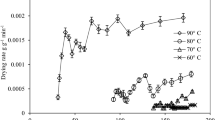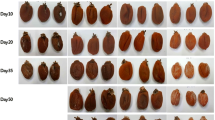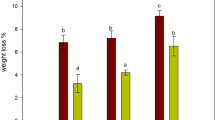Abstract
Analysis of the physicochemical properties, bacteria numbers, and sensory quality of vacuum-packaged compressed biscuits (VCB) was conducted at room temperature and (or) elevated temperatures to ascertain the main deterioration indicator. The acid value (AV) was determined as the deterioration index and the limiting value was 3.28 mg g−1. The deterioration curves of VCB between 45 and 85 °C were investigated and the changes of AV followed a first-order reaction. A modified Arrhenius model was selected for shelf life prediction (SLP). For analyzing the factors associated with prediction accuracy, the R2, %RMS values of the prediction model, and the prediction errors of shelf life from accelerated shelf life tests (ASLT) were evaluated. The results showed that the number of replicates was the most important factor for prediction accuracy, followed by the time intervals for sampling and the number of points fitted for determining the deterioration curve. At the appropriate sampling interval, 9 points fitted in the AV change curves with three replicates were necessary. In the experimental design of ASLT, the results indicated that the number of temperatures had the greatest impact on the accuracy and at least one low temperature close to room temperature should be used when designing ASLT. However, for a long shelf life product such as VCB which the shelf life is more than 2 years, on the premise of prediction accuracy, taking into account the test cycle and cost, a certain number of relative higher temperatures (65, 75, and 85 °C) can be used in ASLT.




Similar content being viewed by others
References
Anese M, Manzocco L, Nicoli MC (2006) Modeling the secondary shelf life of ground roasted coffee. J Agric Food Chem 54:5571–5576
Berenzon S, Saguy IS (1998) Oxygen absorbers for extension of crackers shelf-life. LWT-Food Sci Technol 31:1–5
Calligaris S, Manzocco L, Kravina G, Nicoli MC (2007) Shelf-life modeling of bakery products by using oxidation indices. J Agric Food Chem 55:2004–2009
Calligaris S, Pieve SD, Kravina G, Manzocco L, Nicoli CM (2008) Shelf life prediction of bread sticks using oxidation indices: a validation study. J Food Sci 73:51–56
Cardelli C, Labuza TP (2001) Application of Weibull Hazard Analysis to the determination of the shelf life of roasted and ground coffee. LWT-Food Sci Technol 34:273–278
Cardello A (1995) Food quality: Relativity, context and consumer expectations. J Food Qual Pref 6:163–170
Cohen ELI, Saguy I (1985) Statistical evaluation of Arrhenius model and its applicability in prediction of food quality losses. J Food Process Pres 9:273–290
Corradini MG, Peleg M (2007) A Weibullian model for microbial injury and mortality. Int J Food Microbiol 119:319–328
Devlieghere F, Geeraerd AH, Versyck KJ, Bernaert H, Van Impe JF, Debevere J (2000) Shelf life of modified atmosphere packed cooked meat products: addition of Na-lactate as a fourth shelf life determinative factor in a model and product validation. Int J Food Microbiol 58:93–106
DIN 10961 (1996) Schulung von prüfpersonen für sensorische prüfpersonen. 1996–08
Duyvesteyn WS, Shimoni E, Labuza TP (2001) Determination of the end of shelf life for milk using Weibull hazard method. LWT-Food Sci Technol 34:143–148
Ergun R, Lietha R, Hartel RW (2010) Moisture and shelf life in sugar confections. Crit Rev Food Sci 50:162–192
Freitas MA, Costa JC (2006) Shelf life determination using sensory evaluation scores: a general Weibull modeling approach. Comput Ind Eng 51:652–670
Gacula MC, Singh J (1984) Statistical methods in food and consumer research. Academic, New York
Hough G, Langohr K, Gómez G, Curia A (2003) Survival analysis applied to sensory shelf life of foods. J Food Sci 68:359–362
Hough G, Garitta L, Sánchez R (2004) Determination of consumer acceptance limits to sensory defects using survival analysis. Food Qual Prefer 15:729–734
Kulchan R, Boonsupthip W, Suppakul P (2010) Shelf life prediction of packaged cassava-flour-based baked product by using empirical models and activation energy for water vapor permeability of polyolefin films. J Food Eng 100:461–467
Kwolek WF, Bookwalter GN (1971) Predicting storage stability from time-temperature data. Food Technol 25:51
Labuza TP, Riboh D (1982) Theory and application of Arrhenius kinetics to the prediction of nutrient losses in food. Food Technol 36:66–74
López-Duarte AL, Vidal-Quintanar RL (2009) Oxidation of linoleic acid as a marker for shelf life of corn flour. Food Chem 114:478–483
Magari RT (2007) Uncertainty of measurement and error in stability studies. J Pharmaceut Biomed 45:171–175
Magari RT, Murphy KP, Fernandez T (2002) Accelerated stability model for predicting shelf-life. J Clin Lab Anal 16:221–226
Miyashita K, Takagi T (1986) Study on the oxidative rate and prooxidant activity of free fatty acids. J Am Oil Chem Soc 63:1380–1384
Palazón MA, Pérez-Conesa D, Abellán P, Ros G, Romero F, Vidal ML (2009) Determination of shelf-life of homogenized apple-based beikost storage at different temperatures using Weibull hazard model. LWT-Food Sci Technol 42:319–326
St. Angelo AJ, Vercellotti J, Jacks T, Legendre M (1996) Lipid oxidation in foods. Crit Rev Food Sci 36:175–224
Tijskens LMM, Hertog MLATM, Nicolaï BM (2001) Modelling the use of time-temperature indicators in distribution and stock rotation. CRC Press LLC, Boca Raton, pp 412–413
Van Boekel MAJS (1996) Statistical aspects of kinetic modeling for food science problems. J Food Sci 61:477–486
Yanar Y, Celik M, Akamca E (2006) Effects of brine concentration on shelf-life of hot-smoked tilapia (Oreochromis niloticus) stored at 4°C. Food Chem 97:244–247
Compliance with Ethics Requirements
Conflict of Interest
Bo Wang declares that he has no conflict of interest. Longen Xiao declares that he has no conflict of interest. Liangping Jiang declares that she has no conflict of interest. Bo Li declares that she has no conflict of interest. This article does not contain any studies with human or animal subjects.
Author information
Authors and Affiliations
Corresponding author
Rights and permissions
About this article
Cite this article
Wang, B., Xiao, L., Jiang, L. et al. Evaluation of Accelerated Test Factors through the Development of Predictive Models in Vacuum-Packaged Compressed Biscuits. Food Anal. Methods 8, 1618–1628 (2015). https://doi.org/10.1007/s12161-014-0035-0
Received:
Accepted:
Published:
Issue Date:
DOI: https://doi.org/10.1007/s12161-014-0035-0




